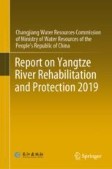Search
Search Results
-
Change of River–Lake Relation and the Regulation of Dongting and Poyang Lakes
The Dongting Lake and Poyang Lake (hereinafter referred to as the Two Lakes), lie on the south bank of the middle reach of the Yangtze River and are...
-
New Economic Model of Eutrophication of Shallow Lakes and the Existence of Equivalent Policies
The search for Skiba points in infinite-time optimal control problems with several steady states is an active research area. In this paper, we apply...

-
Impacts of Invasive Species in the Laurentian Great Lakes
The Laurentian Great Lakes are subject to numerous anthropogenic perturbations, among which invasive species are notable. Sequential invasions of...
-
Pollution characteristics and risk assessment of surface sediments in the urban lakes
The objective of the manuscript was to evaluate the concentration and distribution of nutrients and heavy metals (HMs) in the sediments of urban...

-
Dynamics of human-induced lakes and their impact on land surface temperature in Toshka Depression, Western Desert, Egypt
Changes in land-use/land-cover (LULC) give rise to several environmental problems which modify the microclimate of a region. Therefore, land surface...

-
Response mechanism of sediment organic matter of plateau lakes in cold and arid regions to climate change: a case study of Hulun Lake, China
Lake organic matter is one of the important forms of terrestrial carbon, and its sedimentary evolution is affected by many factors such as climate...

-
The Great Masurian Lakes: Hydrological Regime and Summer Phytoplankton
The lakes of the Great Masurian Lakes System create the largest lake complex in Poland hydrologically divided into three basins – Northern, Central,...
-
Advances in Remote Sensing of Great Lakes Algal Blooms
Many regions of the Great Lakes now see recurring cyanobacterial harmful algal blooms (cyanoHABs), with documented repercussions for ecosystem...
-
Does Alumina-Refining Waste Increase the Nutrient Level in Tropical Mesotrophic Floodplain Lakes?
Several floodplain lakes of the Orinoco River have been impacted by alkaline alumina-refining waste including red mud, a by-product from the Bayer...

-
Bioaccumulation and health risk assessment of heavy metals in European eels taken from Lakes Köyceğiz (Turkey) and Võrtsjärv (Estonia)
Monitoring heavy metal contaminants in fish is important for the assessment of environmental quality as well as food safety. In this study, European...

-
A modeling approach to the efficient evaluation and analysis of water quality risks in cold zone lakes: a case study of Chagan Lake in Northeast China
Due to the influence of complex regional climate, water quality perturbation factors of lakes in cold regions are complicated, and the uncertainty of...

-
Binational Efforts Addressing Cyanobacterial Harmful Algal Blooms in the Great Lakes
Cyanobacterial harmful algal blooms (cyanoHABs) are a recurring impairment in many of the lakes and connecting water bodies that make up the...
-
Merging of the Case 2 Regional Coast Colour and Maximum-Peak Height chlorophyll-a algorithms: validation and demonstration of satellite-derived retrievals across US lakes
Water quality monitoring is relevant for protecting the designated, or beneficial uses, of water such as drinking, aquatic life, recreation,...

-
A review of the application of the macroinvertebrate-based multimetric indices (MMIs) for water quality monitoring in lakes
The increasing stress on lake ecosystems is affecting their functioning such as providing goods and services to inhabiting organisms and riparian...

-
Stakeholders’ Interests and Participation in the Sustainable Use of the Lakes Along the Danube Floodplain. A Romanian Sector as Case Study
Lakes and wetlands within large river floodplains represent some of the most endangered ecosystems at global scale. In this framework, raising...
-
Deep learning–based remote sensing estimation of water transparency in shallow lakes by combining Landsat 8 and Sentinel 2 images
Water transparency is a key indicator of water quality as it reflects the turbidity and eutrophication in lakes and reservoirs. To carry out remote...

-
Resuspension traps for the removal of nutrients and algae from the sediments of shallow lakes
PurposeThe effective removal of internal pollution is of great importance for lake management and eutrophication control in shallow lakes. A new...

-
Assessing On-Water Recreation Experiences in Midwestern U.S. Glacial Lakes: Identifying Areas of Conflict and Agreement
Lake-based recreation resources are bound by physical, social and economic qualities which often lead to conflicting experiences and perspectives on...
-
A method of assessing the depth of contaminated sediments that should be removed in lakes: a case study of Tangxun Lake, China
The depth of contaminated sediments constrains the water environment of large shallow lakes and can affect shallow lake water quality through...

-
Assessment of lakes of Vadodara city in terms of water quality indices and their comparison
The water quality index plays a vital role in defining the overall characteristics of a water body. The current article discusses and compares three...

